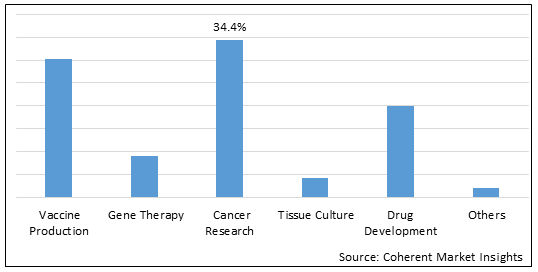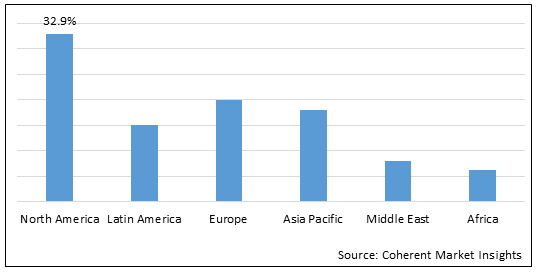The Future of Cell Culture Where Product Standards Continue to Rise
Cell culture is the process of isolating cells from an animal or plant source and growing them in a controlled environment (in vitro). Additionally, this artificial environment has the nutrients needed for cell growth and proliferation, including the ideal temperature, gases, pH (Potential of Hydrogen), and humidity. Tissues can be mechanically or enzymatically stripped of their cells prior to cultivation. The cells that need to be grown could also come from an established cell line or cell strain.
Global Cell Culture market is estimated to be valued at US$ 19,198.0 million in 2022 and is expected to exhibit a CAGR of 7.2% during the forecast period (2022-2030).
Figure 1. Global Cell Culture Market Share (%), by Application, 2022

Increasing investment in the R&D (research and development) by the key market players to develop new cell culture product is anticipated to propel the market growth
Increase in investment by key market players in research and development for development of cell culture product is expected to drive growth of the the global cell culture market over the forecast period. For instance, on July 27, 2021, Pall Corporation, a global supplier of filtration, separations and purification products, announced that they, along with Cytiva, a company involved in the research and development of life-saving vaccines, biologic drugs, and novel cell and gene therapies, had jointly invested US$ 400 million in cell culture media.
Figure 2. Global Cell Culture Market Share (%), by Region, 2022

Increasing adoption of strategies such as acquisition by major players operating in market is expected to fuel growth of the cell culture market.
Increasing inorganic strategies like acquisition by key players in market is expected to drive market growth over the forecast period. For instance, on February 01, 2021, Cytiva, a company involved in the research and development of life-saving vaccines, biologic drugs, and novel cell and gene therapies, acquired Vanrx Pharmasystems, a Canada-based company that makes robotic aseptic filling machines to fill vials, syringes, and cartridges, to increase the production of cell culture and gene therapies.
Cell Culture Market Report Coverage
| Report Coverage | Details | ||
|---|---|---|---|
| Base Year: | 2021 | Market Size in 2022: | US$ 19,198.0 Mn |
| Historical Data for: | 2017 to 2020 | Forecast Period: | 2022 to 2030 |
| Forecast Period 2022 to 2030 CAGR: | 7.2% | 2030 Value Projection: | US$ 33,452.8 Mn |
| Geographies covered: |
| ||
| Segments covered: |
| ||
| Companies covered: | Corning Incorporated, Merck KGaA, Sartorius AG, BioSpherix, Ltd., Cell Culture Company, LLC, Thermo Fisher Scientific Inc., VWR International LLC, and Lonza. | ||
| Growth Drivers: |
| ||
| Restraints & Challenges: |
| ||
Global Cell Culture Market– Impact of Coronavirus (COVID-19) Pandemic
Since the COVID-19 virus outbreak in December 2019, the disease has spread to over 100 countries across the globe and the World Health Organization had declared it a public health emergency on January 30, 2020.
COVID-19 has affected the economy in three main ways: by directly affecting production and demand of drugs and vaccines, by creating disruptions in distribution channels, and through its financial impact on firms and financial markets. Due to nationwide lockdowns, several countries, such as China, India, Saudi Arabia, UAE, Egypt, and others, faced problems with regard to the transportation of drugs and vaccines from one place to another. However, the COVID-19 had a positive impact on the cell culture market, owing to the increase in the awareness regarding the COVID-19 and increase of funding in R&D (research and development) of COVID-19 vaccines.
Global Cell Culture Market: Key Developments
In March, 2021, Thermo Fisher Scientific, an U.S.-based supplier of scientific instrumentation, reagents and consumables, and software services, announced a launch of new Gibco Human Plasma-like Medium (HPLM), a new formulation designed to resemble the natural cellular environment found in the body. It is the first cell culture medium that mimics the metabolic profile of human plasma and is intended to give researchers a realistic view of cell growth within the human body.
Global Cell Culture Market: Restraint
Cell biology involves extensive R&D on new therapies such as stem cell and gene therapies. The equipment, reagents, and other products associated with research must be of the highest quality to provide accurate results. Owing to the growing need to maintain high-quality standards (through the use of high-grade products) and comply with guidelines set up by regulatory bodies, the cost of cell biology research has increased considerably. Thus, high cost is a restraining factor in the global cell culture market.
Key Players
Major players operating in the global cell culture market include Corning Incorporated, Merck KGaA, Sartorius AG, BioSpherix, Ltd., Cell Culture Company, LLC, Thermo Fisher Scientific Inc., VWR International LLC, and Lonza.
barringtonsampe1980.blogspot.com
Source: https://www.coherentmarketinsights.com/market-insight/cell-culture-market-116
0 Response to "The Future of Cell Culture Where Product Standards Continue to Rise"
Postar um comentário